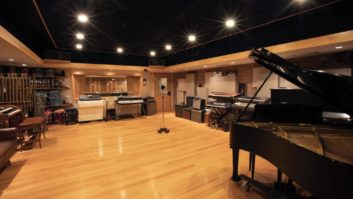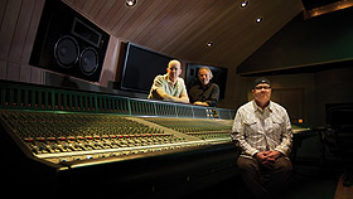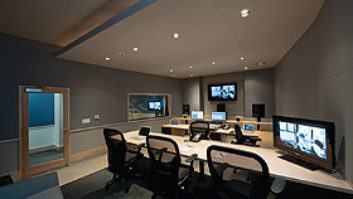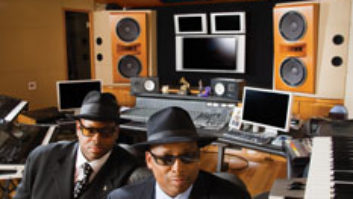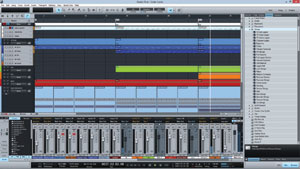
Technology changes so rapidly, and equipment prices come down so dramatically, that once a year we like to revisit a popular Mix feature where we ask three writers, “If you had x amount of dollars, how would you outfit your studio?” The only common assumption? We don’t make them buy a computer; we presume they are already working with their favorite.
MUSIC CREATION: $10,000
By Markkus Rovito
It’s not everyday that a person gets to start fresh. Say your bedroom studio burns down, but thanks to your online backup of all your music and $10,000 in insurance money, all is not lost. In fact, everything is gained, as your options for a new project studio configuration run toward the infinite. Rather than go for as much stuff as we can grab for 10 grand, we’re targeting quality over quantity, with each piece meant to be indispensable, and all at a footprint that will fit on a mid-sized, flat desktop. (All prices are MSRP.)
Perhaps the most crucial decision for any music maker is what DAW software to choose, and then which hardware to pick for controlling it. The modern trend is for software makers to also create or at least endorse specific hardware for their DAW, thereby ensuring lockstep interaction between the hardware and software. If you’re already firmly attached to a specific DAW (see Craig Anderton’s great column on switching DAWs, http://bit.ly/WuVas6), you may want to stick with such software/hardware combinations as: Avid Pro Tools 10 with Mbox Pro interface and Artist Control controller ($2,766.90 total); Steinberg Cubase 7 with UR28M interface and CC121 controller ($1,648.98 total); or Propellerhead Reason 6.5 with Balance interface and Nektar Panorama P6 keyboard controller ($1,229.98 total).
However, in this scenario, we’re choosing a setup with open-ended hardware meant to be software-agnostic. And in the spirit of a clean slate, we’re going with the surprising upstart DAW, PreSonus Studio One 2.5 ($449.95, Mac/PC). When Studio One launched about two years ago, it seemed dubious to unleash another such program to a DAW-saturated world. But with an efficient, musician-friendly interface and constant development, the recent Studio One 2.5 was released to critical acclaim and has garnered a rabid following. In addition to its well-rounded expected features like guitar-amp modeling, and a complement of effect and instrument plug-ins, Studio One 2.5 incorporates integrated Melodyne pitch correction, a cool approach to comping, track transform from virtual instrument to multitrack audio and back, Soundcloud inside the browser, editing of multiple instrument tracks at once, and many audio quantizing, organizational and internal mastering features.
In short, Studio One is a full-fledged DAW perfect for refreshing your approach to music making, and it supports the Mackie Control protocol, which leads to the Mackie Control Universal Pro ($1,499). This popular and time-tested controller offers near-instant mapping for almost every DAW software available today, nine 100mm motorized faders, eight channel strips with the ability to control as many software channels as you need, full transport controls with jog wheel, LCD display, many assignable function buttons, MIDI interface and more. You can also expand it if needed with the Mackie Control Extender Pro.

Mackie Control Universal Pro
For an audio interface, we need something that finds the sweet spot between high audio quality, affordability and flexibility. MOTU’s interfaces in general fit that bill, and specifically, the Track16 ($595) utilizes a 44-inch breakout cable to keep the footprint of the 8.4-by-5-inch interface small, while still offering 16 ins and 14 outs, including optical I/O, MIDI I/O, two guitar ins, two mic ins, and four line-level I/Os. It has both FireWire and USB, as well as an internal mixer with DSP for dynamics and effects. If needed, you can expand it with another MOTU interface.

MOTU Track16
Rather than investing in some amazing hardware synths or a master keyboard workstation, which can run into the thousands of dollars, we’re sticking with a package of software instruments and effects, a MIDI keyboard controller, and one analog synth module for that irreplaceable warmth. For a collection of stellar virtual instruments and effects, you can’t go wrong with Native Instruments Komplete 8 Ultimate ($1,099, Mac/PC). You get it all: 50 software products, including the Kontakt 5 sampler, Reaktor 5.6, Guitar Rig 5 Pro, Absynth 5, FM8, Massive, Battery 3, tons of drums, keys, piano and orchestral soundware; and a hard drive for the 240 GB of data. We also recommend another external hard drive for hosting samples and/or recording to. The Glyph GT 062E ($475) gives you 4TB of capacity at 7,200 RPM with FW800, USB 2.0, eSATA connectivity and RAID compatibility. Glyph has earned its reputation as reliable backup.
For reining in all those NI plug-ins, as well as your other MIDI needs, the Novation Impulse 61 ($499.99) gives you the crucial Automap 4 technology, which detects the active plug-in and maps the Impulse’s controls—including nine faders with buttons, eight knobs, eight pads, and transport controls—accordingly. With 61 semi-weighted keys, USB and MIDI I/O, the Impulse 61 has a handle on both your instruments and your DAW.

Novation Impulse 61
With companies like Moog Music and Dave Smith Instruments (DSI) going strong, analog synth lovers can enjoy all the lush sound of the golden age of analog along with new modern processing features, USB MIDI integration, and endless patch memory. Every studio can benefit from some analog signal path. We wanted a polyphonic analog synth module to control with the Impulse, and the DSI Prophet ’08 ($1,699) provides eight amazing-sounding voices at a price that fits our budget. The all-analog signal path includes two oscillators, three envelopes, four LFOs, and a gated sequencer per voice, as well as a Curtis lowpass filter. The one thing missing from the Prophet ’08 is an external input for processing audio through the filter. If you’re looking for that, check out these monophonic options from Moog: the Minimoog Voyager Rack Mount ($2,795), the Slim Phatty ($845) or Minitaur ($679).
If you’re anything like Nas, all you need is one mic. So, why not make it a good one? Our choice is the modern classic, the Neumann TLM 103 ($1,099) large-diaphragm condenser. With a capsule from the legendary U87, transformerless circuitry, and the ability to handle SPLs up to 138dB without distortion, the ultralow-noise TLM 103 will treat your recording right, whether its a buttery smooth vocal or the thunderous crack of a snare drum. In lieu of acoustical room treatment, we’ll pair the Neumann with the sE Electronics Reflexion Filter 3.5 ($399). Another modern standard, the Reflexion Filter mounts to a standard mic stand and uses six layers of sound diffusion to substitute for full-room treatment on your vocal and instrument recordings.

Neumann TLM 103
You don’t want to skimp on monitoring options, so we’ve chosen the Dynaudio DBM50 active speakers ($1,250 a pair) and the Shure SRH1840 headphones ($875). The DBM50s give you Dynaudio’s dependably accurate sound and a 50W bi-amped design that is angled upward to give you a reliable sweet spot when they’re situated at desktop height. Generous EQ switches in the back let you dial in the sound for your room. Finally, the SRH1840 cost a pretty penny, but they concentrate on super-audiophile quality, as well as comfort over long listening sessions. The open-backed headphones give you a spacious sound, and you get an extra set of luxuriously cushy earpads, as well as a variety of detachable cables.

Shure SRH1840
Total cost (MSRP): $9,939
THE MIX ROOM: $25,000
By Kevin Becka
In this budget class, you have to be careful not to overthink your studio’s capabilities. For instance, you’re not going to be able to track a band in this category without cutting serious corners and settling for tools that will make your job a tough one. For that reason, I’m limiting my gear picks to mixing in the box, mastering and simple overdubs like vocals, acoustic guitar or other mono or stereo recording channel workflows. I’m shopping for price here, as well, so we’re talking street, not retail.
Let’s start with the transducers at the front end since this will be where you’ll spend most of your money. You need a good pair of microphones for stereo applications and a single, versatile mic for recording vocals. The DPA 2011C mics reviewed in this issue are a great place to start ($799 each). DPA pitches these for live sound use, but I think that’s an underestimation. The 2011C is moderately priced by DPA standards, is versatile, sounds great and can grow with your studio. The capsule is interchangeable with other DPA products so you can mix, match and upgrade easily. Their design is optimized for excellent rear and side rejection, meaning they’re great for close-quarter recording where off-axis noise may be a problem, like a control room. They also take a ton of level at 146 dB SPL, so they excel across a range of applications from screaming guitar cabinets to acoustic guitar and piano.

DPA 2011C
Next is the vocal mic, and the Lauten Atlantis FC-387 is a great choice ($1,499.) It is a large-diaphragm condenser with three distinct circuit paths, meaning you can essentially EQ within the mic. If you’re recording a brash saxophone, kick it down to the gentle setting, or if you’re recording hand percussion and want more top, move the switch to the Forward position for added upper-frequency definition.

Lauten Atlantis FC-387
It would be great to have one great analog recording channel, and the Retro Powerstrip or Millennia STT-1 are both excellent choices. The Powerstrip ($2,895) is a tube unit with a vintage vibe featuring a transformer coupled Class-A tube microphone preamplifier, passive EQ, variable-mu tube compression and both a highpass filter and a separate highpass sidechain filter. The STT-1 is also a channel strip with EQ, compression and a high-quality mic preamp. It is just a bit more money ($3,067) but offers Twin-Topology so you can choose whether to go tube or solid-state at each stage: The EQ, compressor and preamp are all separately switchable between paths. With these two choices you can add personality to your vocal or single-channel recordings before you get inside the box.
For an interface, I’ve chosen the Universal Audio Apollo Quad ($2,499), which as a bonus offers some excellent preamps and access to UAD-2 plug-ins. It’s also Thunderbolt-ready for portable use, has an integrated software mixer, and, recently announced at NAMM, is expandable by chaining two together. This buys you more DSP power for the plug-ins, plus an extra four preamps. Growth potential is always a great bonus when you’re buying gear, and these extra preamps get you within the range of a larger tracking room for no extra money—just add more mics.

Universal Audio Apollo Quad
The Apollo comes with a small collection of classic plug-ins, but we’ll need more. I chose the following UAD-2 plug-in bundles: the Magnetic Tape ($599), Classic Compressors ($399), EMT Classic Reverbs ($359), Ampex ATR0-102 Mastering Tape Recorder ($349), and Fatso Jr./Sr. ($299). To expand the plug-in options on the Native side I’ve chosen the McDSP Emerald Pack V5 ($1,495), SoundToys Native Effects Bundle ($495), Waves Native Platinum Bundle ($1,600), Celemony Melodyne Studio ($569) and Antares Auto Tune ($299). These native options offer other plug-in flavors, plus the ability to tune up your performances for the final mix.

McDSP Emerald Pack V5
The big question is which DAW to use, and that depends on whether you’re Mac or PC-based. For Mac I’ve chosen Pro Tools 10 ($699), which is a real bargain since we don’t need HD horsepower for this room. I’ve also chosen to add the Complete Production Toolkit ($1,999) which offers expanded track counts (256), disc caching, surround mixing, advanced automation functions and more. If you’re on the PC side of things, then it’s Sequoia 12 from Magix. This audio production powerhouse features 64-bit or 32-bit operation, many mastering features, the latest loudness metering for broadcast and post users, spectral track editing and much more.

MAGIX Sequoia 12
Now that we’re done inside the box, let’s get out to our monitors using the Dangerous Music Source ($899). This affordable back end features two speaker outputs, two headphone outs, the ability to monitor digital, analog and USB sources separately or together, and more.

Dangerous Music Source
For speakers we’re going big with Focal SM9s ($3,595 each). Although this is our biggest expense, we’re saving money and real estate because the SM9s offer both two- and three-way operation at the push of a button. This allows you to optimize the space in your listening area while getting another reference for your mixes—without buying a second pair of monitors. The SM9s have an extended bottom end via the top-mounted passive radiator, negating the need for a sub, which is also a money saver.

Focal SM9
So there you have it. The total comes in just above the $25k mark, but with some nips, tucks and creative wrangling you can get it under budget. What’s great about this particular group of products is that they are all high-quality choices that will give you the best-sounding tracks possible, and ultimately, that’s what is going to make you happy when you hit the space bar.
TRACK AND MIX: $100,000
By Wes Maebe
In this world of working in-the-box, I prefer to bring audio out of the screen territory. That’s why this is going to be an analog-based setup.
We have to track and mix, so we’re going to spend the bulk of the budget on an amazing-sounding desk; I’ve chosen one of my all-time-favorite-sounding boards, the API 1608. This beast comes in at $52,400, but don’t be put off by the price tag, as you get a lot of bang for your buck. This 16x8x2 API comes loaded with 16 548B mic/line pre’s, each with their own direct output. You’ll have the use of 8 auxes and 8 echo returns.

API 1608
The console features 12 classic 550A and 4 560 equalizers. A full VU meter bridge helps you keep an eye on levels, although with the ridiculous amount of headroom that the API gear provides, levels should not be an issue. Keep in mind that the 1608 has a bunch more empty 500 Series slots, which we’ll fill with a selection of different flavors later on.
Even though we’re playing with the larger budget here, we still need to watch the pennies. So, rather than spending and extra 11 grand on the automation fit for the 1608, I’m putting in an Avid Artist Control ($1,500). This will allow hands-on access to DAW automation, plug-ins and provide a very useful and time-saving transport section.
Having been a Mac user since I started out as an audio engineer, I’m putting in the latest Mac Pro 12 core ($3,799). And although this machine comes with a 1TB internal drive, I like to keep the audio from the system drive, so I’m adding a Glyph GPT50 500GB external drive. Now we need to get audio into the Mac.
Our next major tool for the machine room part is Universal Audio’s Apollo Quad core interface. For $2,499, this interface will give you a great sound and some killer plug-in action. The Apollo allows you to record 24-bit/192kHz, gives 8 analog inputs with 4 preamps, 14 analog outs and 10 digital I/Os. It comes out of the box with the UAD LA-2A, the 1176 and the Pultec EQP-1A plug-ins. We’re also going to add a handful of extras.
Now that Avid has made Pro Tools open to third-party hardware, we can run Pro Tools 10 with our UAD Apollo and benefit from the Pro Tools ease of use and fast editing power. And that’s going to be our main DAW.

Pro Tools 10
Besides the artist and your ears, the mics are your most important tools in the studio. They’re the ones that will capture all these magical moments. As you’ll be tracking a wide variety of instruments in this room, we need to stock up on useful and character-filled microphones, so this is going to be another area where we’ll be spending a good chunk of cash.
To cover all the bases, our list contains the usual suspects like Shure, AKG, Sennheiser, Royer and Neumann, and we’ll add some exotic large- and small-diaphragm condensers, a couple of valve mics and a ribbon or two. Once again, refer to the full list for these, but let’s have a closer look at a few of the lesser known ones that made the cut.
For the main vocal mic, I’ve decided on the Australian-made BeesNeez Jade. This large-diaphragm valve mic is in their producer series. I’ve always been a fan of a Neumann Valve U47 on vocals, and these mics are really hard to come by—especially if you want one that’s in good working condition. When I heard the Jade, it blew my mind. It sounds exactly like a 47, with a nice full body, a crisp top end and the balls you expect from a valve mic. Almost every time I use this mic on vocals, I end up not using EQ when it comes to mixing.

BeesNeez Jade
As we’re talking about vocals, just to add another flavor to the mix, I really like the AEA KU4. This hypercardioid ribbon mic is stunning. I used it in combination with my favorite 47 on vocals. The result was unexpected and utterly amazing. It’s so warm and open at the same time and gives you a very smooth, vintage sound. It’s not cheap, but you will instantly fall in love with it.

AEA KU4
We don’t have the biggest room, and that is why I have steered clear of too many stereo-miking options. However, we will be setting up drums in here and we can be pretty certain that we’ll end up recording small string sections, acoustic guitars and other acoustic instruments. One hot stereo pair of mics will cover that nicely. The Lauten Audio Torch ST221 are a matched pair of small-diaphragm valve condensers, and they sound ridiculously sweet. Once again, you get the round warmth from a valve mic, combined with the crisp, small-capsule sound. These mics may well turn out to be your main workhorses for strings, drum overheads, acoustics, room mics and piano.
You can have the best microphones in the world, but without great monitoring you’d be driving blind. Our main monitors are going to be the Focal Twin 6Bs. These monitors give you a clean and true representation of what’s going on in the recording process and will provide you with honest monitoring at the mix. In addition to the Focals, we’ll have a set of the AE Pro 22, giving us a more hi-fi/domestic reference. Sterling makes a nice custom monitor bridge for the API 1608 to hold the speakers and save on space. We’ll put our main monitors on a pair of Iso Acoustics decouplers, which do wonders for the sound.

Focal Twin 6B
For headphones, we run a Rane HC6S headphone amp, giving extra volume control for the artists and yourself, and the cans of choice are a pair of classic and very comfortable beyerdynamic DT250s.
Although this unit does not really belong in this category, the main reason we procured the Lexicon PCM92 is mainly to dial in some reverb for the artists while recording. Naturally this machine can be used in conjunction with the API when mixing.
With the API, the UAD and our extra plug-ins, we are pretty much covered, but it’s always nice to have some extra flavors at hand. The 1608 gives us a bunch of extra 500 series slots, acting like a big lunch box and allowing us to expand our tool chest quite significantly.
I’ve put in a Radial X Amp 500 Series to help out with re-amping bass and guitars, the brand new Cranesong Falcon 500 Series compressor for character and warmth, an ultra-clean DAV 501 preamp which has an amazing DI and tons of headroom, an extra API 525 compressor to complement the rest of the 1608 vibe and Moog’s new 500 Series Analog Delay.

Cranesong Falcon 500 Series
On top of all the extra 500 modules, I’ve specified a top-class workhorse: the Massenburg 2020 channel strip, which will give you another taste of mic pre, an extremely versatile compressor and another great EQ. It’s a costly unit, but you can use it on anything and it’ll come in real handy when it is time to mix the vocals.

George Massenburg Labs 2020
Right, we’re set up with all this amazing high-end gear, but there are a few bits and pieces we still need to tie it all together.
Our impressive microphone list would be rather useless without their stands, so lets add in seven K&M boom stands so we can mike up the drum kit, put up the vocal mics and our Lauten Audio stereo configuration, a couple of K&M short stands for the kick, snare and guitar cabs and an sE Reflection Filter so we can avoid any unwanted room sound on certain instruments and vocals.
And just in case you need to do some keyboard programming, the Teenage Engineering OP-1 keyboard will give you all the functionality you need to get the job done, and then some!

Teenage Engineering OP-1
You’re going to be spending a lot of time in this fabulous setup, with a lot of different people and egos and the vibe will always be important. So, by means of “wombification,” let’s purchase a nice lava lamp and the piece de resistance, a Saeco Odea coffee machine. Ask any producer/engineer or artist what they like about a studio, and except for the equipment, 9 out of 10 will say, “the coffee!”

Saeco Odea
Fire it all up, have fun and rock out!
Click “Next” to get the full $100K equipment list.
$100K EQUIPMENT LIST
Hardware
API 525: $1,100
API 1608: $52,400
Avid Artist Control: $1,500
[avid.com]
Cranesong Falcon: $1,125
DAV 501: $400
Glyph GPT 150: $170.49
Lexicon PCM92: $1,800
Mac Pro: $3,799
Massenburg 2020 (+9015 PSU): $7,000
Moog Analog Delay: $899
[moog.com]
Radial X Amp: $250
Teenage Engineering OP-1: $849
UAD Apollo: $2,499
Software
Cranesong Phoenix: $450
Metric Halo Production Bundle: $699
Pro Tools 10 Native: $699
Sonnox Elite Bundle: $1,174
UAD plug-ins
ATR: $349
EMT 140: $199
EP-34: $199
Fairchild: $149
Little Labs Phase: $99
Neve 33609: $249
Shadow Hills Mastering Compressor: $299
Microphones
AEA KU4: $4,500
AKG 451: $500
[akg.com]
Audix D6: $200
BeesNeez Jade: $2,100
Lauten Audio Torch ST221: $1,600
Neumann KM184: $850
Royer 121: $1,295
Sennheiser 609: $110
Sennheiser 421 x 3: $1,230
Shure Beta 91: $240
Shure SM57 x 2: $198
Shure SM58: $99
ShureSM7B: $350
Monitors
AE Pro 22: $1,299
beyerdynamic DT 250 x 2: $400
Focal Twin 6BE: $3,700
Iso Acoustics ISO LE 8E200: $150
Rane HC6S: $419
[rane.com]
Sterling Custom 1608 monitor bridge: $630
Stands
K&M boom stands x 7: $560
K&M short stands x 2: $170
sE Reflection Filter: $300
Odds and Sods
Lava Lamp: $30
Saeco Odea coffee machine: $600
Grand total: $99,886.49
*I donate the remaining $113.51 to Kevin Becka, as he ran over a little.
